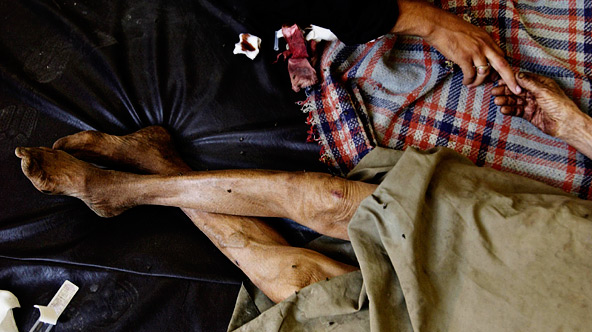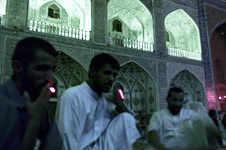
Najaf, Iraq, 26 August 2004. An old man injured by shrapnel is treated in the makeshift shrine hospital. At the end of the siege, supplies were non-existent and bloody rags littered the floor of the room.
Photograph: Phillip Robertson
At one empty intersection, another man in Bedouin robes said we could cross Medina Street, explaining that he had just crossed the U.S. cordon without any problems. When we arrived at the open boulevard, at a hole between two Bradleys, we held our hands up over our heads in surrender and stepped into the street. It was a weightless feeling.
A block deeper in, the city was ruins. Scorched shards of buildings faced streets filled with burned cars and fallen electrical cables. We had entered a no-man's-land between the two opposing forces. Talib left us when we came across a second Bradley and turned back toward the suburbs. A few minutes later, some Mahdi children replaced him, leading us deeper into the city. We followed the boys through a burned market, which smelled like death, bordered by the ruined Tho al Fikar Hotel. The boys laughed and ran ahead of us, shouting, "Which channel, which channel?"
When the Mahdi boys yelled into the ruins, yells came back from empty windows in the buildings where the fighters were hiding. A head would appear wearing a green band of the Mahdi Army. Fighters waved to us. We waved to them so they wouldn't shoot us. We came upon a small group of Mahdi Army fighters who offered to help us go to the shrine. I told their commander about wanting to speak to Sheikh Ahmed Sheibani, an advisor to Moqtada al Sadr, and they agreed to send someone with us. Past the hotel we arrived at the boundary of the old city, a wide, open boulevard we would have to cross. When we were halfway to the other side, walking with our hands up, a sniper opened fire on us. Thorne was caught in the middle of the street and had to take cover out in the open, I ran behind a column and listened to the rounds slam into the concrete a few inches away. By the time we were out of the sniper's line of fire, we'd crossed into the old city, inside Mahdi lines. I gave the old letter of safe passage, written by Sheikh Ahmed, to a young man and he told us to come with him. The shrine's dome glowed in the sun, five hundred yards away. Rows of young men covered in ammunition belts, holding rifles and heavy weapons, hid in the shade of the long street. They shouted and called to us as we passed them. Ammunition and rockets were carefully stacked near their feet. We were at the Shrine a few minutes later and, like devoted Shiites, when we crossed the threshold, we touched the great carved wooden doors.
Inside the Walls
The Shrine of Imam Ali is at the center of the old city, a few hundred feet south of the largest cemetery in the world. Its walls, laid out in a perfect square, are a deep red brick and they are at least fifty feet high. The outer walls are plain, but inside the gates, there is a sea of white marble which reflects the sun. The inner walls are covered in blue tiles that evoke the infinite forms of God. In the center of the courtyard, there is the tomb covered in gold tiles. Caretakers continually wash the marble flagstones with water to keep them clean. When we arrived after crossing through the burned no-man's land, the steps of the south-facing gate were smeared with blood from wounded fighters. The caretakers were busy because blood must not spill on the grounds of a mosque. They did not have much time to rest. Young Mahdi fighters running down Rasul Street were being blown to pieces by armored units across Medina Street. Fighters loaded up wounded and dead Mahdi volunteers in wooden carts and ran them up to the south gates to a makeshift infirmary in the mosque. The doctors let us in. We watched one fighter carry a dead comrade to the infirmary, a severed forearm in a cigarette box, a stump of a leg jutting from his black dishdasha. The fighter, mad with grief, screamed at the doctor to save his friend, but the body was already the color of ashes. I watched the doctor pretend to take a pulse from the corpse to calm the fighter down. There was blood running on the marble floor as the fighters brought in another wounded militiaman who made the victory sign with both hands as they treated him.
Sheikh Ahmed Sheibani, the Mahdi cleric and spokesman, wasn't in when we arrived, so the fighters gave us water and allowed us to wait in the Sheikh's office. We could hear the First Cavalry fighting in the cemetery and there was a fierce battle between armored units, aircraft, and the militiamen hiding in underground tombs. With each passing hour, the Mahdi Army was losing ground, their men facing unbelievable American weapons with no hesitation. Most of the men who went into the cemetery to fight the Americans didn't come back. An Apache gunner named Joe Bruhl told me about the battle and said, "We'd fly over, and I'd punch off a missile at one of their mortar teams, killing all of them. Then I'd see other guys run in and pick up the weapons the first guys dropped and start firing at me. I didn't know whether to call them crazy or tip my hat. I must have killed dozens of them a day."
Bruhl asked me why they did it, although as a devout Christian, he could have easily answered his own question. It was the Mahdi Army's war at the end of the world.
Moqtada al Sadr, the lion, was not anywhere to be found. I looked, watched for bodyguards and other signs that the man was nearby, but there was nothing. We would have known if he was in the Shrine. Moqtada was hidden away somewhere, a kind of secret weapon who would never risk being martyred. After all his promises of sacrifice and bravery, he let the other young men walk into the blades of the killing machine for him.
 LEAD IMAGE: 17 August, 2004, Najaf, Iraq. Young followers of Moqtada al Sadr inside the shrine of Imam Ali during the siege.
LEAD IMAGE: 17 August, 2004, Najaf, Iraq. Young followers of Moqtada al Sadr inside the shrine of Imam Ali during the siege.Photo: Thorne Anderson
© Phillip Robertson, 2009-2020.
